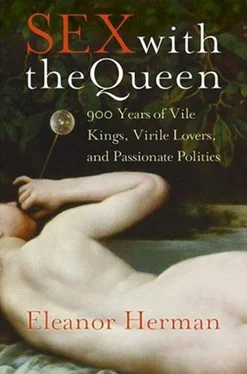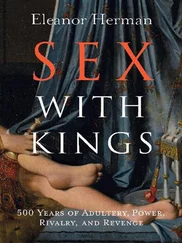One day as a teenager, after suffering weeks from a decayed tooth, the future Catherine the Great agreed to have it pulled. A “surgeon” came to her room armed with a pair of pliers and yanked out the offending tooth—and a chunk of jawbone as well. Blood gushed all over her gown. The swelling and pain were so shocking that Catherine did not leave her room for a month, and even when the swelling went down, the dentist’s five fingers were imprinted in blue and yellow bruises at the bottom of her cheek.
Elizabeth Charlotte, duchesse d’Orléans, came from hearty German stock and hated the Versailles doctors. Whenever she heard that Louis XIV was sending doctors to attend her, she bolted the gilded doors to her room and refused to emerge until she was well. She believed the best antidote to illness was a vigorous two-hour walk in her gardens regardless of the weather, followed by a stout German beer and some spicy sausages.
“Here no child is safe,” she wrote a friend back in Germany in 1672, “for the doctors here have already helped five of the Queen’s to the other world; the last one died three weeks ago, and three of Monsieur’s, as he says himself, have been expedited in the same way.” 40In 1683 she accused palace doctors of killing the wife of the heir to the throne. The princess expired “through the ignorance of the doctors, who killed her as surely as if they had thrust a dagger into her heart.” 41
When royal physicians succeeded in killing almost the entire French royal family in 1712 by bleeding them to death during a measles epidemic, the nurse of the youngest prince, the two-year-old Louis, hid with him in a closet for three days until the doctors stopped their search. By the time she emerged, all other heirs to the throne were dead, and the entire future of France rested on the slender shoulders of the future Louis XV.
Though the field of medicine made tremendous strides in the second half of the nineteenth century—germs had been discovered under a microscope, hygiene was greatly improved, and chloroform was used as an anesthetic—some royal women were not permitted to enjoy the benefits. When Marie of Romania was due to deliver her first child in 1894, her grandmother Queen Victoria sent an English physician with instructions to administer chloroform as the pain became intense.
The Romanian priests objected heatedly, citing the Bible’s statement that women must pay for Eve’s sin by bringing forth children in pain. Romanian doctors agreed. Forcing the priests and local doctors from the room, the British doctor administered the anesthetic, anyway, much to the relief of the pain-stricken princess. But for her second delivery a year later, the Romanian royal family and the attending doctors absolutely forbade painkillers. Marie suffered horribly.
Perhaps Louis XIII best summed up royal health care in 1643 when the forty-one-year-old monarch lay dying of a stomach complaint. Those at his deathbed marveled at the king’s admirable resignation to God’s will. The king’s calm acceptance of his fate, however, vanished the moment his chief physician walked in the room. Scowling at his doctor, Louis snapped, “I would have lived much longer if it had not been for you.” 42
2. THE QUEEN TAKES A LOVER
Women are as roses, whose fair flower
Being once displayed, doth fall that very hour.
—WILLIAM SHAKESPEARE
BEFORE WE EMBARK ON OUR JOURNEY THROUGH NINE CENTURIES of queenly adultery, we must first understand that there were two kinds of queens—a ruling queen and a queen consort. If she had power in her own right—as a hereditary queen or queen regent—some at court might grumble about her love affairs but there was no chance of beheading or divorce. Queen Isabella II of Spain had numerous lovers, and her poor little consort Don Francisco was in no position to say a word. Peter the Great’s daughter Empress Elizabeth, who never officially married, had four lovers at once. The spinster Queen Elizabeth I of England had passionate flirtations with courtiers, and the widowed Queen Victoria fell in love with her groom. But no one at these courts dared utter a word of reproach to the hereditary monarch.
Widowhood often bestowed great power on a formerly powerless queen consort. Having suffered thirty years of malice and neglect as the wife of Louis XIII of France, the widowed Anne of Austria ruled for her young son, Louis XIV, together with her politically brilliant lover Cardinal Mazarin. Catherine the Great of Russia—who hastened herself into an early widowhood by having her husband murdered—grabbed power in her own right and took as many lovers as she wanted without fear of reprisals.
Some queen consorts were married to complacent husbands who permitted them not only political power in their own right, but love affairs as well. For thirty years starting in 1788 the odd ménage à trois of King Carlos IV of Spain, Queen Maria Luisa, and her lover, Manuel Godoy, lived happily together, calling themselves “the earthly trinity.” 1The king went out hunting every day, while the queen and her lover—whom the king obligingly named prime minister—made love and policy. Carlos was grateful to Godoy for taking the burdens of statecraft off his shoulders so he could chase rabbits. Carlos was so devoted to hunting that one day, when he was informed that one of his children lay dying, he said, “Well, what can I do about it?” and jumped on his horse. 2
Carlos had inherited his passion for the hunt from his father, Carlos III who, whenever he passed a tapestry with the figure of a horse, could not restrain himself from lifting one leg as if he were going to mount the animal and ride off. His son Ferdinand IV of Naples, brother of Carlos IV of Spain, shared the family’s genetically predisposed mania. Ferdinand permitted his wife, Queen Maria Carolina, to rule his nation with her lover Sir John Acton, readily nodding agreement to most of their political recommendations so that he could race back to the fields.
When Carlos was visiting Ferdinand in 1821 and fell deathly ill, a messenger was sent to recall Ferdinand from the hunt. The king refused. “Either my brother will die, or he will recover,” he said. “In the first case, what will it matter to him whether I amused myself hunting or not? In the second, being a crack sportsman himself he will be delighted to see me return with a good bag of game to cheer his convalescence.” 3Carlos died without his brother, but with Ferdinand’s name on his lips.
Those royal women who possessed power—whether by birthright, widowhood, or as a gift from husbands who wanted to go hunting—flaunted their love affairs. These women rewarded their lovers as generously as kings rewarded their mistresses. But powerless royal women were forced to hide their affairs. Their lovers not only received no financial benefits; far worse, they lived under the threat of torture and execution if the affair became public.
Fed up with her husband and palace life, the powerless queen consort who decided to take a lover could resort to tried-and-true stratagems to hide the affair.
We must bear in mind that royalty almost never had a moment alone. Even on the chamber pot, servants would be in attendance to lift up the heavy skirt or knee-length jacket, and hand the soft piece of cotton used for cleaning the body. At night, if a royal couple desired intimacy, they might send their servants to sleep in the antechamber or in front of the door. But royal husbands and wives had—and still have—their individual suites and often didn’t sleep together. When the king slept alone, he usually had bodyguards in the room for his protection and servants to summon a doctor if he became ill or to bring him food or drink if requested.
Читать дальше












